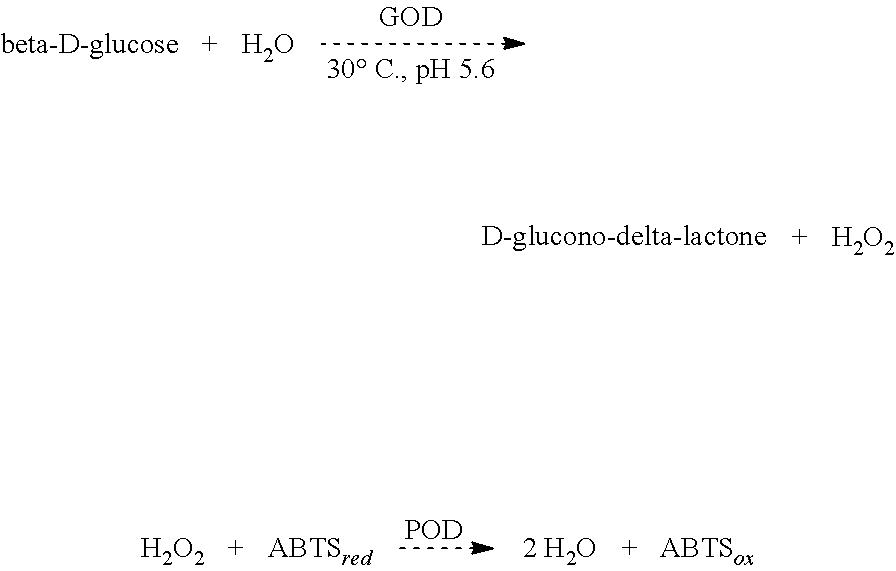Method for decolorization of sugar solution using enzymes
a technology of enzymes and sugar solutions, applied in the field of sugar solution decolorization, can solve the problems of affecting the quality of sugar products, so as to prevent color formation
- Summary
- Abstract
- Description
- Claims
- Application Information
AI Technical Summary
Benefits of technology
Problems solved by technology
Method used
Image
Examples
example 1
Enzymes Used in the Invention
[0076]The present invention have been illustrated using examples of representative oxidoreductase enzymes
[0077]Glucose oxidase (GOX) activity of the invention is measured in GODUF units as described above.
Glucose Oxidase from Aspergillus niger
[0078]Glucose oxidase is commercially produced by Novozymes A / S under the trade name Gluzyme Mono 10.000BG (Novozymes A / S, Bagsværd, Denmark). The enzyme (SEQ ID NO: 2) used in examples 1-7 was a purified form of Gluzyme Mono derived from an industrial strain of Aspergillus oryzae in which the Aspergillus niger glucose oxidase gene (SEQ ID NO: 1) was introduced.
[0079]The start material was approximately pH 4.5 and the conductivity was 20 mS / cm. The start material also contains some catalase activity. During the purification procedure, the glucose oxidase could easily be separated from catalase due to the visual properties of the proteins; glucose oxidase is yellow and catalase is green.
[0080]The frozen start materi...
example 2
Use of Glucose Oxidase for Treatment of Sugar Cane Primary Juice, Mixed Sugar Cane Juice and Raw Sugar Solution
[0092]Chemicals: The filter aid Celite, Distilled water, hydrochloric acid, sodium hydroxide were obtained from Sigma chemicals.
Enzymes: Experimental Glucose Oxidase (GOX) described in Example 1; Scytalidium catalase from Example 1.
Membrane filters (PVDF, 25 mm diameter, pore size 0.45 μm); Glass fiber filter, microplate reader Eon from Biotek
20 GODUF / mL were added 10 mls of the sugar cane primary juice, sugar cane mixed juice and raw sugar solution (30° Bx) under the following conditions:
[0093]All tubes are placed in a rotary shaker at 25 RPM and 40° C. for 6 hours. The enzyme reactions were terminated by heat inactivation in a boiling in water bath for 15 minutes, followed by 5 min in ice bath.
[0094]For the decanted juice, half of the sample (5 mls) was heat treated to inactivate the enzymes while the other half was not heat treated. The tubes were then centrifuged at 400...
example 3
Enzymatic Removal of Color from Sugarcane Juice with A. niger Glucose Oxidase, AnGOX
[0101]In this example, mixed juice samples derived from a milling tandem are considered. Hence, 1% diatomaceous filter aid (CAS 68855-54-9; Manufacturer: CELITE CHILE S.A.-WORLD MINERALSCellite) was added to the sugarcane juice to aid in the filtration. The mixture was then filtered through a vacuum filtration device with a glass filter to eliminate the suspended solids. The filtered samples were transferred to Falcon 50 mls conical tubes. To each assay tube containing 10 mL of juice, a dose of 400 U / (mL juice) of AnGOX was added. The tubes were incubated at 40° C. under shaking conditions (75 rpm) for at least 6 hours. After the six hour incubation, each sample was divided in two portions and then, one portion was submitted to an inactivation treatment in boiling water as in Example 2. All samples were centrifuged, diluted to 5 times, pH adjusted to 7 (+ / −0.1), filtered with 0.45 micron PVDF membran...
PUM
 Login to View More
Login to View More Abstract
Description
Claims
Application Information
 Login to View More
Login to View More - R&D
- Intellectual Property
- Life Sciences
- Materials
- Tech Scout
- Unparalleled Data Quality
- Higher Quality Content
- 60% Fewer Hallucinations
Browse by: Latest US Patents, China's latest patents, Technical Efficacy Thesaurus, Application Domain, Technology Topic, Popular Technical Reports.
© 2025 PatSnap. All rights reserved.Legal|Privacy policy|Modern Slavery Act Transparency Statement|Sitemap|About US| Contact US: help@patsnap.com



